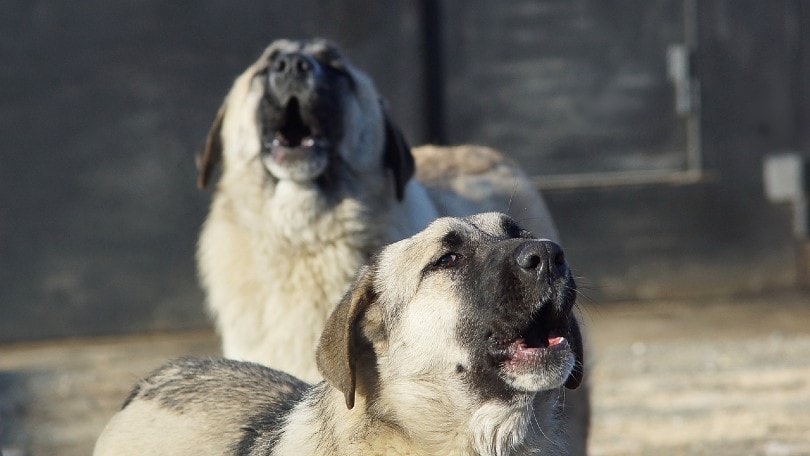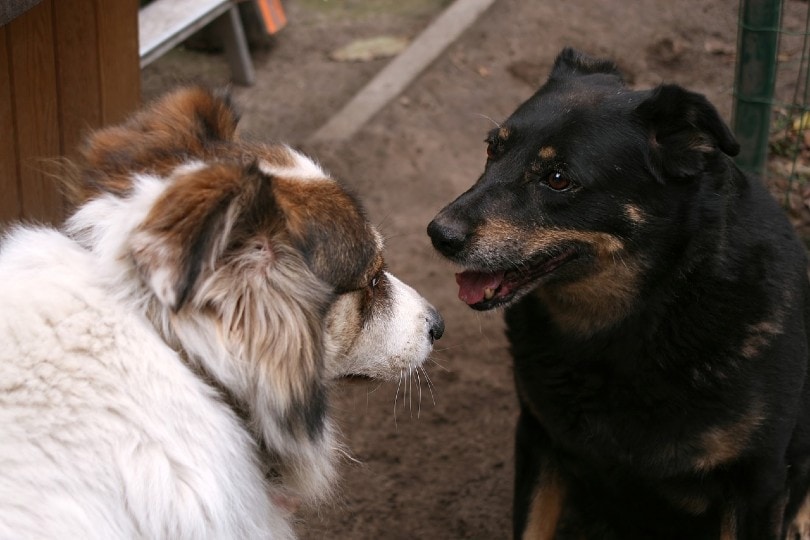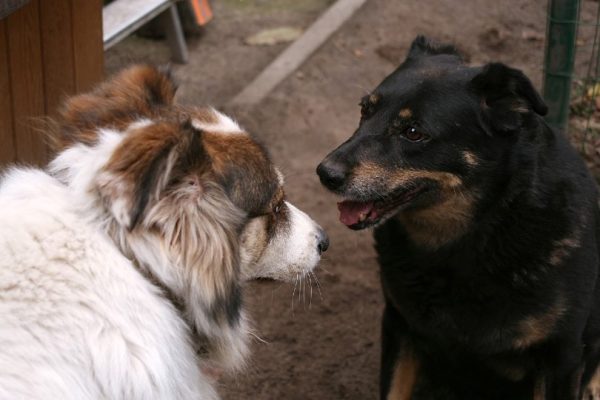Dogs may not use words, but they do talk to each other.
Their communication mainly takes place through body language. A dog can say a great deal by where they place their ears and their tail. However, some vocalizations also play a role.
Dogs understand this shared language through a mixture of innate knowledge and learning, a bit like how people understand facial expressions. You get better at understanding other people through learning. But most people are born with an innate sense of how to read others’ cues.
Understanding our dog’s body language does not come naturally to us, though. Many people may misinterpret their dog’s body language. A wagging tail does not mean a dog is necessarily happy, for instance.
This misunderstanding can potentially lead to dangerous situations, such as when you interpret a stressed dog as completely fine.
Taking the time to learn how a dog communicates can be extremely helpful. It should be something that every dog owner learns.
The 3 Categories of Canine Communication
There are three different categories that all canine communication falls under. Body language is the most important of these, though others also play a role.
1. Body Language

Body language is vital when dogs speak with each other. Most of their communication will be presented through visual cues. This is quite similar to people, though we often consider words to be the most important.
There are many common misconceptions about canine communication, especially when it comes to body language.
For instance, dominance and submissive behaviors among dogs (and wolves, for that matter) have been heartily disproven. This theory has even been rebuked by the man who first presented it. Therefore, dog body language doesn’t fall into either the dominant or submissive categories.
Here is a quick breakdown of the various types of visual communication that dogs provide to other dogs.
Head Posture

Where a dog points their head is typically where they want to go. If a dog points their muzzle directly toward another, it may be a sign of aggression. Alternatively, turning their head away can indicate that they are friendly.
Many dogs will greet others with their head slightly tilted to one side.
That said, a dog who is directly facing another may not necessarily be aggressive.
Mouth Shape
Everyone knows that a snarling dog is not a happy dog. However, mouth shape can be important in other ways.
Panting can be a sign of relaxation. A loose jaw often indicates that the dog is relaxed and content. However, panting can also be a sign of stress.
On top of snarling, some dogs exhibit “smiling,” which can be taken to be the opposite of snarling. It is a social signal, even though the teeth are technically shown.
Yawn

Dogs may yawn to help them stay awake, similar to people. However, they may also yawn when stressed.
A passive dog may yawn to indicate that they are trying to defuse an aggressive dog. Usually, this is followed by the animal turning their head away.
Eyes
Where a dog looks matters. Eye contact is not a sign of aggression. However, a dog may “ignore” another to defuse a potentially aggressive situation. If a dog isn’t looking at another one, it may be a sign that they aren’t comfortable.
If a dog stares something down, they are interested and unsure. The eyes of a relaxed dog will move around with ease. This behavior is similar to that in people.
Tail

A dog’s tail is a vital sign. A stiff tail usually indicates aggression or unease. If the tail is straight out, it is likely a sign of aggression. A tail that is tucked between the legs stiffly could be fear-based.
A tail-wagging doesn’t necessarily mean that the dog is happy. Dogs may also wag their tails when they are insecure about the situation.
Dogs who wave their tail slightly off to the left are unsure and may potentially be scared of the situation. Those that wave it slightly to the right are comfortable.
Ears
Ears are another vital sign to watch in dogs. However, a dog’s ear shape can play a role in how this communication works. Some dogs are unable to move their ears in specific ways due to their breed.
If your dog’s ears are artificially altered, it may affect their communication even more.
Erect ears are often a sign of alertness. Ears that are stiff but pulled back may be a sign of aggression or fear. Dogs will often flatten their ears in anticipation of conflict, as they don’t want the other dog to bite their ears.
Dog ears that are pulled down are often a calming sign, though. This is the expression that dogs often take when meeting new people, for instance.
Body
There are many ways that dogs can communicate with their bodies. Bristled fur often indicates aggression, for instance.
A dog may stand upright when they are aggressive and excited. Lowering the body has the opposite effect and may indicate that the dog is scared. A crouched posture is commonly called the “play bow” and indicates that the dog wants to play.
2. Vocal

Dogs can also communicate through a range of vocal noises. These fall into two categories: long-range and short-range. This is similar to the vocalizations used by coyotes and wolves.
Barking comes in many different forms. The canine may bark rapidly to indicate surprise or distress. Continuously, slow barking is often more aggressive—the dog knows that the threat is there, and they don’t like it.
Many dogs may happily bark as well, such as when they see someone they know.
Growling is typically aggressive, but not always. Higher-pitched growling may be a sign of surprise. It’s closer to a yap than a deep growl. Some dogs may also growl when playing, but this is usually higher pitched as well.
Howling is common among most dogs. It may indicate that the dog is bored or isolated. Most dogs will howl when they are lonely, but many will do it just for fun as well.
Whines can mean all sorts of things. People usually interpret them as being fearful, but they can also indicate something else. For instance, a low-pitched whimper may be a sign of excitement.
Panting can be a way for dogs to regulate their body temperature. However, they may also do it when they are stressed or excited.
Play sneezes frequently occur during play. They aren’t real sneezes.
3. Olfactory

Dogs have sensitive noses. They often communicate through the use of pheromones, which humans can’t smell. Different scents are produced when the dog is fearful or angry.
Pheromones can also indicate sex and age. If a female is in heat, her scent will change. Pregnant dogs also smell different.
These pheromones are primarily produced in urine, which helps the dog figure out what others around them are feeling. This is also why dogs may sniff each other’s behinds when they meet—it helps them learn about the other dog’s current status.
Final Thoughts
Dogs communicate similarly to people in many ways. Body language plays a key role, just like it does for people.
Vocal signals may also indicate a dog’s emotions. However, these are rarer and less important than visual signals. For dogs, vocal signals are second to body language. They don’t communicate a wide range of thoughts and aren’t used nearly as often.
A dog is always using body language, while vocal signals are only used when necessary.
Dogs are also constantly producing pheromones. Humans cannot smell these scents. However, dogs use them to communicate all sorts of information. For instance, a dog can tell the sex and age of another dog through their scent alone.
Humans have access to both the visual and auditory language that their dogs are giving off. We can learn to read these cues to understand our dogs better. However, pheromones are out of our reach because we can’t smell them.
Dog communication can differ from dog to dog. Their ears can play a significant role, for instance. But a German Shepherd is going to use their ears differently than a Beagle.
Some dogs are also better at communication than others. While much of it is innate, practice does make perfect. A dog that isn’t socialized may have difficulty communicating, which is why they are often more aggressive and fearful. They don’t understand what the other dog is saying.
Learning about canine body language is essential for all dog owners. Specifically, you should learn how your dog communicates, which can only be done by paying attention to them.
Related Read:
- How to Take Care of Your Dog: Our Top 22 Tips
- Why Do Dogs Yawn?
- 8 Scents Your Dog Can’t Resist (Some May Surprise You)
Featured Image Credit: Ihtar, Pixabay












